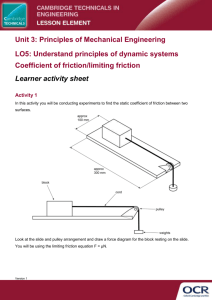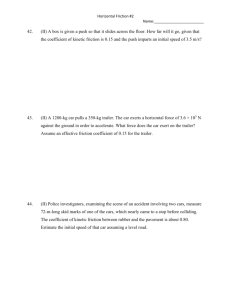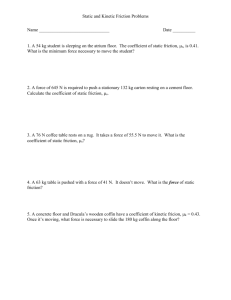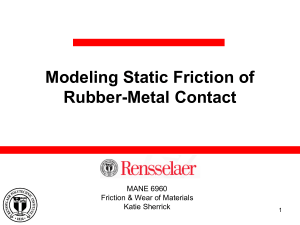friction4
advertisement
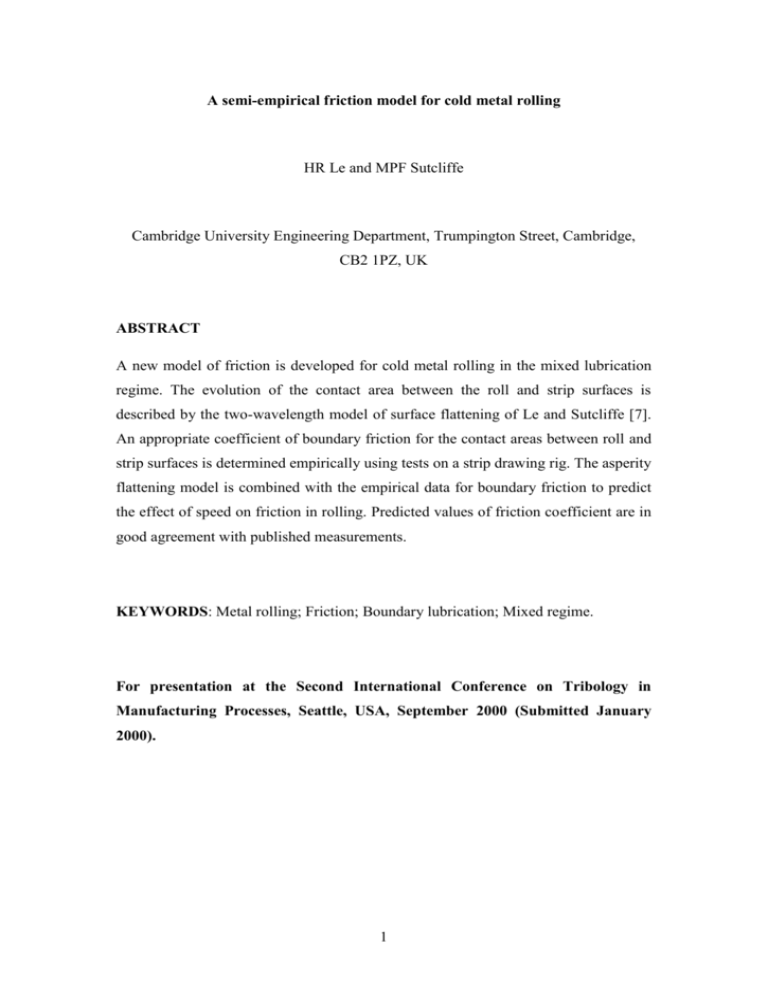
A semi-empirical friction model for cold metal rolling HR Le and MPF Sutcliffe Cambridge University Engineering Department, Trumpington Street, Cambridge, CB2 1PZ, UK ABSTRACT A new model of friction is developed for cold metal rolling in the mixed lubrication regime. The evolution of the contact area between the roll and strip surfaces is described by the two-wavelength model of surface flattening of Le and Sutcliffe [7]. An appropriate coefficient of boundary friction for the contact areas between roll and strip surfaces is determined empirically using tests on a strip drawing rig. The asperity flattening model is combined with the empirical data for boundary friction to predict the effect of speed on friction in rolling. Predicted values of friction coefficient are in good agreement with published measurements. KEYWORDS: Metal rolling; Friction; Boundary lubrication; Mixed regime. For presentation at the Second International Conference on Tribology in Manufacturing Processes, Seattle, USA, September 2000 (Submitted January 2000). 1 LIST OF FIGURES 1 Schematic of the strip rolling process. 2 Cross-section of the geometry between a smooth roll and rough strip with a twowavelength surface roughness. The rolling direction is out of the plane of the figure. (a) When roll and strip first contact (d=0) (b) After some asperity flattening. 3 Evolution of hydrodynamic and average asperity pressure in the roll bite, R=25 mm, t1=0.82 mm, r=25%, ur=0.1 m/s, 0=0.35 Pas, =2.210-8 Pa -1. 4 Evolution of surface roughness amplitude and average contact ratio in the roll bite, R=25 mm, t1=0.82 mm, r=25%, ur=0.1 m/s, 0=0.35 Pas, =2.210-8 Pa -1. 5 Experimental set-up of strip drawing simulation. 6 Variation of friction coefficient with theoretical smooth film thickness in strip drawing. 7 Comparison of predicted and measured average friction coefficient for cold rolling using an experimental mill, t=0.5 m, r=0.06m, L=50m, =5m, R=30 mm, t1=0.35 mm, r=25%, 0=0.077 Pas, =2.210-8 Pa -1. 2 NOMENCLATURE a Contact ratio of short wavelength roughness a Contact ratio averaged across the width b Length of the roll bite F Drawing force ht Mean film thickness h* Constant in Reynolds’ equation N Indentation force pa ( pv ) Pressure on the top (valley) of the short wavelength roughness p ( pa ) Mean pressure (on the asperity tops) averaged across the width of the contact q Reduced hydrodynamic pressure, q 1 exp( pv ) r Reduction in strip thickness R Roll radius x Co-ordinate in rolling direction Y Plain strain yield stress of the strip Pressure viscosity coefficient of the lubricant Temperature viscosity coefficient of the lubricant 0 Initial (current) r.m.s amplitude of long wavelength component t Combined r.m.s amplitude of long and short wavelength components 0 Initial (current) r.m.s amplitude of short wavelength component 0 ( ) Initial (current) height of crushed short wavelength component L Long (short) wavelength Shear strain rate of lubricant 0 Reference shear stress in Eyring model v Shear stress of lubricant Viscosity of lubricant 0 Reference temperature Lubricant temperature Total friction coefficient b ( v ) Friction on the top (valley) of the asperities Friction coefficient averaged through the bite 3 1. INTRODUCTION There is an increasing interest in rolling models from metal rolling industry in order to improve quality, to increase productivity and to reduce wastage. These models are used in set-up programs to develop and optimise rolling schedules and for on-line control. A typical roll bite model will contain frictional, mechanical and thermal components in order to predict process parameters such as roll load, torque and temperature. Although friction is an important part of the overall model, it is not well understood. In practice, it is usually interpreted as a constant and determined from process parameters. An accurate friction model is vital to a successful roll bite model. To achieve a good surface finish and relatively low friction, most cold rolling is in the ‘mixed’ regime where there is pressurised oil between the roll and strip surfaces but also some contact between them. The overall friction coefficient is commonly described by a combination of boundary friction on the contact areas and hydrodynamic shearing of the oil in the valleys. Estimates both of the area of contact ratio and the frictional stresses in the two regions are required with this approach. Several researchers, including Sutcliffe and Johnson [1] and Sheu and Wilson [2], have investigated the way that surface asperities are flattened in the mixed lubrication regime. The essence of these models is to idealise the surface roughness as a uniform one-wavelength array of asperities and to take into account the effect of plastic deformation of the bulk material on the rate of asperity flattening. These models provide quantitative predictions of the oil film thickness and contact ratio. Experiments by Sutcliffe and Johnson [3] showed that the film thickness predicted by these models has good agreements with measurements. However, recent measurements of friction on experimental mill by Tabary et al [4] showed that friction was significantly lower than expected by these one-wavelength models. It is likely that a single-wavelength model of roughness over-simplifies the surface topography. Sutcliffe [5] developed a model for dry rolling in which the surface was modelled by two superimposed wavelengths of roughness. It is found that the flattening rate of the long wavelength asperities is much faster than that of short wavelength components. The predicted contact area between the roll and strip is much reduced by the introduction of the short wavelengths. The predictions of surface roughness amplitudes showed good agreement with the experiments. It is concluded that short 4 wavelength components persist more than long wavelengths and must be considered when estimating contact area and hence friction in metal rolling. Recent measurements of the evolution of random rough surfaces during rolling under mixed lubrication conditions by Sutcliffe and Le [6] were interpreted using the twowavelength approach. Results confirmed that short wavelength components persist more than the long wavelength components. Le and Sutcliffe [7] incorporated hydrodynamic theory into the two-wavelength model of Sutcliffe [5] to investigate rolling with mixed lubrication regime. The predicted change in the amplitude of the surface roughness is in line with measurements. The purpose of the current paper is to apply this model to predict friction in cold rolling. Although the details of the asperity-crushing model can be found from Le and Sutcliffe [7], a summary is described in the next section for completeness. As the boundary friction coefficient plays an important role in the friction model, an empirical estimate of this, using strip drawing, is described in section 3. The predicted friction coefficients are compared with measurements by Tabary et al [4] in section 4. 2. EVOLUTION OF SURFACE ROUGHNESS AND CONTACT AREA In this section, the method used to predict of the variation in film thickness and area of contact ratio through the bite is described. This can then be combined with a frictional model to predict the change in friction through the bite. This part of the model is taken directly from the work of Le and Sutcliffe [7] and only a summary is given in this section. 2.1 Geometry Figure 1 shows a schematic of the rolling process. The strip is reduced in thickness from t1 to t2 by rolls of radius of R. In the current work, it is assumed that the bite is a circular arc, which will be reasonable for strip. For foil a non-circular arc should be considered (Fleck et al, [8]). The length of the roll bite b is given by b (t1 t 2 ) R and the angle between the roll and strip at the inlet to the bite by 5 b R . The strip is assumed as rigid-perfectly plastic. The roll bite is divided into three zones: an inlet zone in which there is no bulk deformation, a transition zone in which there is bulk deformation and a significant difference between the pressures on the asperity tops and in the lubricant in the valleys, and a work zone where the asperity contact pressure equals the lubricant pressure. The surface topography is modelled by longitudinal roughness consisting of two superimposed wavelengths of roughness, as shown in cross section in Figure 2. The two components have wavelengths L and and corresponding initial r.m.s. amplitudes 0 and . The asperities are shown for clarity as triangular in Figure 2; in fact, a pseudo-Gaussian shape is used. The valley depth, contact pressure and area of contact ratio for each of the small-scale asperities are considered. The mean contact ratio a is found by averaging the variation in local contact ratio a across the width of the contact. 2.2 Hydrodynamic pressure For simplicity, it is assumed that the lubricant pressure p v is uniform across the width of the strip, even when there is asperity contact. An averaged Reynolds’ equation is used to derive the variation in reduced hydrodynamic pressure q of the lubricant in the rolling direction, along the x axis, ht h * d (q ) 12 0u dx ht3 1 3 t2 / ht2 (1) The reduced and actual pressures q and p v are related by q 1 exp( pv ) . 0 is the viscosity of the oil at ambient pressure and is the pressure viscosity coefficient. The entraining velocity u u r u s1 2 is given by the mean of the roll and strip speeds in the inlet. ht is the mean film thickness, averaged across the width, t2 is the total variance of the surface roughness and h * is a constant which must be found. 6 2.3 Asperity crushing The inlet zone is very short compared to the roll radius, so that the roll shape here may be taken as a straight line at an angle to the strip surface. In the inlet region local flattening of the asperities takes place, with the difference pa pv between the pressure on the top of an asperity and in the valley equal to the hardness of the asperity 2.57Y. As the contact area between the roll and strip increases going through the bite, the mean contact pressure eventually reaches the yield stress Y of the strip and plastic deformation of the bulk material takes place. The point where this occurs marks the end of the inlet region and the beginning of the transition region. In the transition region the effect of bulk deformation on asperity crushing must be considered and coupled with the variation in hydrodynamic pressure. On the scale of the small wavelength, the difference between the velocity on the top of an asperity and in the valley, and hence the rate of asperity flattening, is determined by pa pv , the difference in pressure between the asperity top and the valley. The actual form of the dependence is detailed by Le and Sutcliffe [7], following the calculations of Korzekwa [9] for an infinite array of similar asperities. Because the asperity geometry varies across the large-wavelength asperity, there is a pressure variation between the top and valley of the large wavelength asperity. This in turn drives asperity flattening on the scale of the long wavelength asperity, which is again modelled using the results of Korzekwa [9]. Asperity flattening on the two scales of roughness is linked using volume conservation. The end of the transition zone is reached when the pressure in the valley approaches that on the asperity tops. It is assumed that the gradient of the hydrodynamic pressure approaches zero at the end of the transition zone, i.e. dq dx 0 . This assumption is adequate for normal rolling conditions where the hydrodynamic pressure builds up fast and the asperity crushing process is confined to short inlet and transition zones. 2.4 Work zone In the work zone, the pressure gradients in both the transverse and rolling direction vanish. However further stretching of the strip leads to thinning of the lubricant film. 7 Constancy of oil flow rate is used to model the variation in surface roughness amplitude and average contact ratio through the bite. 2.5 Theoretical predictions of surface roughness and contact ratio This model described above allows for the solution of interface pressure, surface roughness and contact ratio through the bite. Figure 3 shows the evolution of the mean interface pressure p Y , mean asperity pressure pa Y and hydrodynamic pressure pv Y , for the set of rolling conditions detailed in the figure caption. The initial amplitudes for long and short wavelengths are 0.36 and 0.12 m respectively. The two wavelengths are 50 and 5 m. The s ratio in this case is 0.16, which is typical of 'mixed' regime. Results show that there is a very short inlet zone with no bulk deformation, before the mean pressure reaches the yield stress of the strip. In the transition zone, the hydrodynamic pressure builds up until both the asperity pressure and hydrodynamic pressure equal the overall interface pressure. The results also confirm the assumption that the transition zone is a short proportion of the total bite length. The evolution of the surface roughness amplitudes and the mean contact ratio a under these conditions is shown in Figure 4. Although the inlet zone is very short, it accounts for most of the surface flattening. Further flattening takes place in the transition zone where there is bulk deformation. No significant flattening occurs in the work zone. 3. SIMULATION OF BOUNDARY FRICTION A key variable in estimating friction in the bite is the coefficient of friction on the areas of contact between the roll and strip. The simplest approach is to assume a constant friction coefficient (e.g. Lin et al [10]). Although this assumption may be reasonable at extremely low speed, results presented here and similar results by Marsault [11] suggest that this is not adequate under more typical conditions. Although the reasons for this are unclear, it seems likely that hydrodynamic action creates a thin hydrodynamic oil film under the contact, leading to a transition from true boundary friction to hydrodynamic friction with increasing speed. A transition 8 would be expected as the oil film thickness becomes comparable with the thickness of any absorbed boundary layer on the surfaces. An analogous transition is found for elasto-hydrodynamic contacts by Johnston et al. [12]. In the absence of an appropriate theoretical model for this transition (in particular a model of the way that lubricant molecules are absorbed in the bite), it was decided to adopt an empirical approach, using laboratory measurements to estimate the boundary friction under similar but more controlled conditions. The experimental set-up of the strip drawing rig used for this simulation is shown in Figure 5. A more detailed description is given by Ahmed and Sutcliffe [13]. The simplicity of the set-up and the ease with which process and die conditions can be varied makes strip drawing a much more attractive laboratory test of boundary lubrication mechanisms than corresponding rolling tests. The drawing dies used in the tests are made from heat-treated tool steel. Half die-angles of 3, 5, 10 and 20 degrees are used to vary the lubricant film thickness, which is estimated using the Wilson and Walowit [14] film thickness hw for smooth surfaces hw 60u (2) (1 eY ) where u is the entraining velocity, equal to half the strip velocity at the inlet.. The dies have flat faces polished to a Rq roughness of 0.05 m. The Vickers’ hardness of the dies is around 7000 MPa. The dies are re-polished after two tests to maintain a good surface finish. The specimens are cut from commercially-sourced cold rolled 1050 alloy aluminium strips in the work-hardened condition. The specimens are 6 mm thick, 24 mm in width and 250 mm along the drawing direction. The initial strip Rq roughness is about 0.225m. The Vickers’ hardness is 415 MPa, giving an estimated plane strain yield stress of 161 MPa. Three base mineral oils, HVI 650, M320 and Vitrea 68, were used to vary the theoretical smooth film thickness hw from 1 to 100nm. Properties of the oils are summarised in Table 1. The visocosities of the oils are taken from manufacturers' data sheets, with the variation in temperature approximated by 0 exp 0 , where is the temperature viscosity coefficient and the reference temperature 0 is 20°C. Values of the Eyring shear stress 0 (c.f. section 4) and the pressure viscosity 9 coefficient for Vitrea 68 and HVI 650 are taken from [4] and [15] respectively. Other values in brackets have been estimated by comparison with similar oils. (kg/m3) 0 (Pa s) (C-1) (m2/N) 0 (MPa) Vitrea 68 881 0.149 0.044 (2.210-8) 2.0 M320 891 0.671 0.043 (2.510-8) (2.0) HVI 650 915 1.915 0.079 3.2910-8 2.6 Oil Table 1:Rheological properties of lubricants The tests are operated at very low drawing speed (0.016m/s) to create thin film lubrication. The pull and indentation forces F and N are carefully measured to calculate the (constant) friction coefficient µ using the simple formula: F 2 tan N 1 tan (3) The measured friction coefficients with HVI 650, M320 and Vitrea 68 oils are shown as a function of smooth film thickness hw in Figure 6. The curves are fitted to the measurements using the least mean square method for the two nominal reductions. Although there is some scatter in the measurements, the results reveal a rise in friction coefficient as the film thickness falls from 100 to 1 nm. Reduction also appears to be a significant factor. The friction coefficient at a nominal reduction of 25% is significantly higher than that at 12.5%. This may be a boundary lubrication effect, as the larger reduction leads to a greater area of virgin surface generated on the strip and hence to more severe contact conditions. With the thicker films, the effect of reduction is smaller as the hydrodynamic mechanism becomes more important. The surface finish on the outgoing strip is about 0.125 m in all cases except for the thinnest oil film thickness when significant pick-up occurs on the die surface. This is very close to the value of Rq roughness of 0.1 µm for the dies after the first draw, showing that the strip surface conforms to the die surface. Friction was not significantly altered by the presence of severe pickup on the die surface, suggesting that the roughness of the surfaces is not important; rather the behaviour depends on the boundary lubrication mechanisms. This differs from the rolling situation, where 10 Tabary et al [4] show that the conformance of the roll to the strip to the roll significantly changes during a similar change in the film thickness. 4. FRICTION MODEL To estimate the friction coefficient in cold rolling, the contact areas and the valleys are treated separately. The shear stress in the valleys,v, due to a shear strain in the lubricant is calculated by the Eyring model (c.f. Evans and Johnson [15]) 0 sinh v 0 (4) where 0 is the Eyring shear stress and the viscosity is calculated at the contact pressure. Neglecting the Poiseulle term, the strain rate is estimated by u hv (5) where u is the sliding velocity and hv is the mean film thickness, averaged over the valleys. Both these will change through the bite. Combining equation 4 and 5, the shear stress in the valleys is given by v 0 sinh 1u 0hv (6) The boundary friction coefficient, µb, is extracted from the curve fit shown in Figure 6 with the Wilson and Walowit film thickness calculated from rolling conditions. The overall friction coefficient µ is given by summing the shear stresses on the contact areas and in the valleys and dividing by the pressure p, noting that through the bite the pressure under the contacts equals the valley pressure; i.e. a b (1 a ) v p v (7) To predict the variation in friction through the bite, this friction model is combined with the tribological model of section 2, which predicts the variation of area contact 11 ratio a through the bite. An average friction coefficient is given by summing the shear stress through the bite and dividing by the normal stress. 5. COMPARISON WITH EXPERIMENTS Tabary et al [4] have presented measurements of the average friction coefficient when rolling aluminium strip in the mixed regime with Vitrea 68 as lubricant with rolls of radius 30 mm. Details of the process conditions are given in their paper. Here we compare results from their Figure 6, where rough strip was rolled with smooth rolls, with Rq roughness amplitudes of 0.5 and 0.06 µm respectively. Typical values of 5 and 50 µm for the short and long wavelengths are chosen. Their measured values are compared with theoretical predictions, using the method outlined above and a reduction of 25%, in Figure 7. The speed parameter s is equal to the ratio of the smooth film thickness hw to the combined Rq roughness of the strip and roll, which in this case equals 0.5 µm. In practice, the variation in s covered in the experimental measurements corresponds to a variation of smooth film thickness hw from 5 to 500 µm. The dashed curve is calculated by assuming a constant boundary friction, taking a typical value of 0.09. Since the contribution from the valleys is generally small compared to that from the contact areas, the predicted variation in friction coefficient reflects the change in contact ratio. This approach using constant boundary friction is poor. Moreover, it would not be possible to bring this into line with experiments by judicious adjustment of the boundary friction coefficient. By contrast, the solid line uses the transition in boundary friction coefficient inferred from the strip drawing simulation of section 3. With this modification, the predicted friction coefficients are in good agreements with the measurements by Tabary et al [4]. This supports the suggestion of Marsault [11] that it is the combination of changes in contact ratio and boundary friction factor that accounts for the observed change of friction coefficient with speed. 12 6. CONCLUSIONS (1) A two-wavelength model of surface asperity flattening is applied to lubricated cold rolling in the mixed regime. The model is used to predict the evolution of surface roughness and contact ratio through the bite. It is found that the short wavelength components persist more than the long wavelength components. (2) A strip drawing rig is used to measure appropriate boundary friction coefficients on the contact areas between roll and strip. It is found that the boundary friction changes with the nominal oil film thickness. Strip reduction is also a significant factor. The higher the reduction, the higher the friction coefficient. (3) The asperity flattening model is combined with the empirical boundary friction data to predict the friction coefficient in cold rolling. The predicted friction coefficients have good agreement with published measurements from mill trials. ACKNOWLEDGEMENTS The authors wish to thank Dr. K. Waterson at Alcan International Ltd. and Dr. P. Reeve at Alstom Drives and Controls for their advice. The financial support from EPSRC, Alcan International Ltd. and Alstom Drives and Controls Ltd. is gratefully acknowledged. 13 REFERENCES 1. Sutcliffe, M. P. F. and Johnson, K. L., 1990, “Lubrication in cold strip rolling in the ‘mixed’ regime”, Proc. Instn Mech Engrs, 204, 249-261 2. Sheu, S. and Wilson, W. R. D., 1994, “Mixed lubrication of strip rolling”, STLE, Tribology Trans, 37, 483-493 3. Sutcliffe, M. P. F. and Johnson, K. L., 1990,“Experimental measurements of lubricant film thickness in cold strip rolling”, Proc. Instn Mech Engrs, 204, 263273 4. Tabary, P. E., Sutcliffe, M. P. F., Porral, F. and Deneuville, P., 1996 “Measurements of friction in cold metal rolling”, ASME J. Tribology, 118, 629636 5. Sutcliffe, M. P. F., 1999, “Flattening of random rough surfaces in metal forming processes”, ASME J. Trib., 121, 433-440 6. Sutcliffe, M. P. F. and Le, H. R., 2000, “Measurements of surface roughness in cold metal rolling in mixed lubrication regime”, To appear in STLE Tribology Transactions 7. Le, H.R. and Sutcliffe, M. P. F., 2000 ,“A two-wavelength model of surface flattening in cold metal rolling in mixed lubrication regime”, To appear in STLE Tribology Transactions 8. Fleck, N. A., Johnson, K. L., Mear, M. E. and Zhang, L. C., 1992, Cold rolling of foil, Proc. Instn. Mech. Engrs, 206, 119-131 9. Korzekwa, D. A., Dawson, P. R. and Wilson, W. R. D., 1992, “Surface Asperity Deformation During Sheet Forming”, Int. J. Mech. Sci. 34, 7, 521-539 10. Lin, H. S., Marsault, N., Wilson, W. R. D., 1998, “A mixed lubrication model for cold strip rolling-Part I: Theoretical”, Tribology Transactions, 41, 3, 317-326. 11. Marsault, N. 1998, Modélisation du régime de lubrification mixte en laminage à froid. PhD Thesis, L'Ecole National Superieur des Mines de Paris, France 12. Johnston, G.J., Wayte, R. and Spikes, H.A., 1991, "The measurement and study of very thin lubricant films in concentrated contacts" Tribology Transactions, 34, 187-194 13. Ahmed, R and Sutcliffe, MPF, 2000, “An experimental investigation of surface pit evolution during old-rolling or drawing of stainless steel strip”, For presentation at the 2nd ICTMP, Seattle, Sept 2000 14. Wilson, W. R. D. and Walowit, J. A., 1972, “An Isothermal Hydrodynamic Lubrication Theory for Strip Rolling With Front and Back Tension”, Proc. 1971 Tribology Convention, I. Mech. E., London, pp 164-172. 15. Evans C.R and Johnson, K.L., 1986, “The rheological properties of elastohydrodynamic lubricants”, Proc. Instn Mech Engrs, 200C, 303-312 14
